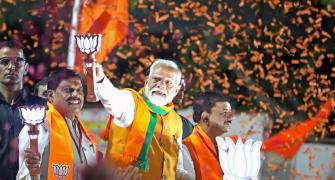Tucked away in a corner of a post office in downtown Singapore is a free-standing booth operated by an employee of GE Money, the consumer finance arm of General Electric Co.
It's a modest display, but a popular one. Lunchtime customers wait patiently in line to apply for personal loans. The GE unit began marketing uncollateralised loans -- with hefty 14 per cent annualised rates -- through SingPost just six months ago. And with just a few dozen well-placed booths offering cash on the spot, it has already carved out a lucrative niche in Singapore's well-developed banking market.
China and India: A visual overview
"We are delivering [financial] products to Singaporeans right where they need them," says Greg O'Callaghan, Singapore chief of GE Money, the brand name of the old GE Consumer Finance in most major markets.
That speaks volumes about the kind of smart tactics GE is using to grab a piece of Asia's booming financial marketplace. Lured by soaring regional growth rates, low capital costs, and credit-starved retail markets, officials at the $15.7 billion GE unit say expansion in emerging Asia is their top priority.
Despite being years behind rivals like Citigroup and HSBC, GE is catching up fast. After just two years in India, for example, GE Money became the No. 2 credit-card issuer in 2002. And to jump-start its business in China, GE bought a 7 per cent stake in Shenzhen Development Bank on Oct. 21. "We're trying to move our centre of gravity to Asia," says David R Nissen, president and CEO of GE Money. "The growth rates in Thailand are double what we have in the mature countries of Europe."
Nissen, who 12 years ago helped set up GE Consumer Finance (now branded GE Money), says that as growth has slowed in mature markets such as Western Europe and Japan, Asia has become increasingly attractive.
In the first nine months of this year, consumer finance accounted for 12 per cent of GE's $123 billion in sales and 13 per cent of its $17 billion in profits. Asia is expected to make up less than one-quarter, or $698 million, of GE's total consumer finance earnings this year.
But it is the fastest-growing segment, up 14 per cent from last year's $610 million. To expand its Asian toehold, over the past 12 months GE has spent nearly $1.3 billion snapping up midsize finance firms in China, the Philippines, and South Korea.
The idea is to leverage widespread awareness of the GE name by tapping into a growing demand from middle-class Asians for credit to pay for everything from cars to groceries to weekend flings on the installment plan.
Until now, that market has been dominated by a handful of players such as Citigroup's CitiFinancial and less reputable firms just a step up from loan sharks. "GE has done well in the region by cherry-picking segments that many of the larger players had overlooked," says Paul Bartholomew, Asian banking consultant at East & Partners Ltd. in Sydney.
Ultimately, GE sees itself becoming a financial supermarket in Asia that offers services ranging from plain-vanilla bank accounts to sophisticated investments such as insurance and securities. But where GE has struck gold first is the market for credit cards and short-term unsecured cash loans in amounts up to $10,000.
At last, China targets spammers
A staple among consumers in Japan -- where GE fine-tuned its business model -- unsecured loans are finding a following elsewhere in Asia for those who prefer borrowed cash to plastic.
One reason is that interest rates on these loans average between 8 per cent and 15 per cent, less than the standard 16 per cent to 22 per cent on outstanding card balances.
Default rates, a potential land mine since the loans are uncollateralised, are kept below 4 per cent with rigorous spot checks based on computerized credit data supplied by regional credit bureaus. "The biggest opportunity in Asia[n finance], we believe, is in the consumer-finance business," says Yoshiaki Fujimori, president of GE Money Asia.
With just 1 per cent of the Asian consumer-finance market, Fujimori sees plenty of room for growth in a fragmented playing field. GE also doesn't hesitate to seek out allies. In India, a seriously underserved credit market, GE has teamed up with large banks.
China and India: From then to now
A key partner is the State Bank of India, with which it launched a joint credit-card program in 1999. That has vaulted GE into a position as India's second-largest card issuer, with nearly 2 million cards in India and $1.2 billion in assets. GE has won fans in India thanks to a speedy application process using Six Sigma quality techniques that cut the wait for a card from weeks down to just days.
To lay the groundwork for a much broader push into Asian finance, GE has been bulking up. Its deal for a piece of China's Shenzhen Development Bank gives it a platform not only for credit cards but also for wealth management.
The Chinese deal came on the heels of the purchase of the Philippines' oldest savings institution -- midsize Keppel Bank -- in October. And GE is negotiating to buy up to 33 per cent of Taiwan's midsize Cosmos Bank. And late last year, it spent $1.2 billion for 43 per cent stakes in two South Korean companies: top auto-financing firm Hyundai Capital Services and No. 3-ranked credit-card issuer Hyundai Card. None of these acquisitions stand out for high margins or rapidly expanding revenue streams. But that's precisely what GE wants. "We don't buy growth," says Nissen. "We grow what we buy."
All the same, Asia's retail banking market is fiercely competitive. Large local players dominate most markets, and megabanks such as Citibank, HSBC, and Standard Chartered have built up substantial operations over the decades.
In addition, other Western banks are rushing into Asia, and that is bound to increase the competition and erode margins. So GE tries to be innovative. For instance, it has linked up its credit-card operations with several retailers and other companies, including Tesco, Hyundai Motor, and Thailand's Central Department Store.
Going Wal-Mart's way
GE officials say the company plans to expand that strategy to markets such as China through partnerships with Wal-Mart and French retailer Carrefour. But some analysts say tie-ups and small-bore investments are no substitute for a vast retail banking network. London-based Asia veteran Standard Chartered PLC has been mentioned as a possible acquisition target that would instantly transform GE into a giant in Asia. GE officials won't comment.
In any event, such a deal would go against the grain of not paying for growth, since Standard Chartered has a market capitalisation north of $25 billion. Instead, GE seems more likely to stick to its playbook of nurturing business in Asia by mixing two parts midsize deals with one part organic growth.







